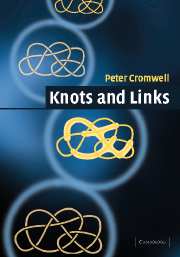Book contents
- Frontmatter
- Contents
- Preface
- Notation
- 1 Introduction
- 2 A Topologist's Toolkit
- 3 Link Diagrams
- 4 Constructions and Decompositions of Links
- 5 Spanning Surfaces and Genus
- 6 Matrix Invariants
- 7 The Alexander–Conway Polynomial
- 8 Rational Tangles
- 9 More Polynomials
- 10 Closed Braids and Arc Presentations
- Appendix A Knot Diagrams
- Appendix B Numerical Invariants
- Appendix C Properties
- Appendix D Polynomials
- Appendix E Polygon Coordinates
- Appendix F Family Properties
- Bibliography
- Index
- Frontmatter
- Contents
- Preface
- Notation
- 1 Introduction
- 2 A Topologist's Toolkit
- 3 Link Diagrams
- 4 Constructions and Decompositions of Links
- 5 Spanning Surfaces and Genus
- 6 Matrix Invariants
- 7 The Alexander–Conway Polynomial
- 8 Rational Tangles
- 9 More Polynomials
- 10 Closed Braids and Arc Presentations
- Appendix A Knot Diagrams
- Appendix B Numerical Invariants
- Appendix C Properties
- Appendix D Polynomials
- Appendix E Polygon Coordinates
- Appendix F Family Properties
- Bibliography
- Index
Summary
We have seen several methods for describing links: as polygons with specified coordinates, as the images of smooth functions, but mostly as pictures. Knot theory is definitely a visual subject. In this chapter we investigate 2-dimensional representations of links, their benefits and limitations.
Pictures of links
Figure 3.1 shows various planar representations of the knot 1050, each with its own pros and cons. Image (a) is quite realistic and appears to show a genuine 3-dimensional object: the shadows and highlights give the impression of depth, allowing the eye to perceive the relative distances of different parts of the knot. It is a computer-generated image produced with the rendering tool POV-Ray. To create it, you need to specify a particular embedding of the knot in ℝ3, a process which can be time consuming. The result looks rigid and you can get a good idea of how the curve is embedded. The other two images are more schematic with simple conventions to indicate which strands pass over and under each other. The outlined diagram (b) is pleasing and effective for small or simple knots; it was used in Rolfsen's catalogue in. However, it becomes confusing for something complex or with many parallel strands. The simple diagram in (c) is certainly the easiest to draw by hand. When drawn by computer, (b) and (c) are in fact produced in the same way: (b) is a white line with black edges and (c) is a black line with white edges.
- Type
- Chapter
- Information
- Knots and Links , pp. 51 - 77Publisher: Cambridge University PressPrint publication year: 2004



